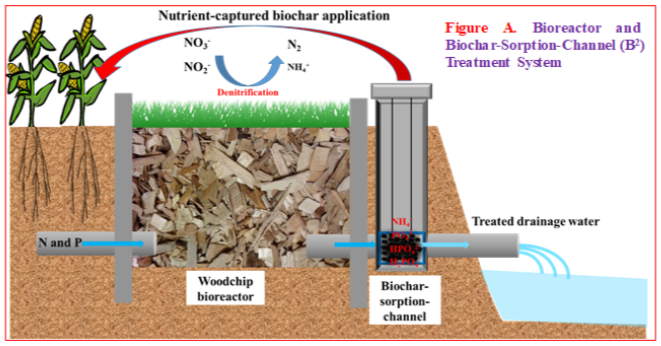Grantee Research Project Results
2021 Progress Report: Development of a Novel Bioreactor and Biochar-Sorption-Channel (B2) Treatment System to Capture and Recover Nutrients from Tile Drainage
EPA Grant Number: R840088Title: Development of a Novel Bioreactor and Biochar-Sorption-Channel (B2) Treatment System to Capture and Recover Nutrients from Tile Drainage
Investigators: Zheng, Wei , Cooke, Richard , Guzman, Jorge , Sharma, Brajendra , Oladeji, Olawale
Current Investigators: Zheng, Wei , Cooke, Richard , Guzman, Jorge , Oladeji, Olawale , Rajagopalan, Nandaksihore
Institution: University of Illinois Urbana-Champaign , Metropolitan Water Reclamation District of Greater Chicago
EPA Project Officer: Ludwig-Monty, Sarah
Project Period: September 1, 2020 through August 31, 2023 (Extended to August 31, 2024)
Project Period Covered by this Report: September 1, 2020 through August 31,2021
Project Amount: $999,377
RFA: Approaches to Reduce Nutrient Loadings for Harmful Algal Blooms Management (2020) RFA Text | Recipients Lists
Research Category: Water , Harmful Algal Blooms , Water Quality , Clean Water
Objective:
The goal of this project is to develop and scale up an innovative bioreactor and biochar-sorption-channel (B2) treatment system (Figure A) to effectively capture nutrients from subsurface drainage water, recycle nutrient-captured biochars as a slow-release fertilizer, and keep nutrients in the closed agricultural loop. The long-term goal of this project is to mitigate the excess nutrient loads to watersheds from agricultural fields, improve water quality, and thereby diminish the occurrence of harmful algal blooms (HABs) and increase agricultural sustainability. To achieve this goal, the following special objectives will be addressed:
- Create designer biochars by pyrolysis of biomass pretreated with lime sludge, and optimize the production conditions to generate a most efficient and cost-effective designer biochar to capture dissolved phosphorus and ammonium-nitrogen (NH4-N).
- Develop an innovative B2 nutrient treatment system by integrating refillable biochar-sorption-channels with woodchip bioreactors (Figure A).
- Demonstrate and scale up the B2 nutrient treatment system to remove nitrate-nitrogen (NO3-N) and capture phosphorus and NH4-N from tile drainage water by conducting field trials.
- Evaluate the developed B2 nutrient treatment system by conducting a scale-up field study.
- Recover nutrients by applying nutrient-captured biochars into agricultural fields as a slow-release fertilizer to improve soil quality and crop yields.
Progress Summary:
Agricultural subsurface drainage is a widely adopted water management practice in the Midwestern U.S. This practice uses perforated conduits to remove excess water from the soil profile to increase crop production and promote soil conservation. However, subsurface drainage systems can also deliver large quantities of nutrients from agricultural fields to surrounding watersheds. This project aims to create designer biochars to effectively adsorb dissolved
phosphorus and NH4-N, develop an innovative B2 treatment system to capture nutrients from subsurface drainage water, and recycle nutrient-captured biochars as a slow-release fertilizer. During this reporting period, we optimized the production conditions to generate the most efficient and cost-effective designer biochar to adsorb dissolved phosphorus from contaminated water. We concluded that the designer biochar would be produced from wood biomass pretreated with 20% lime sludge under 650 oC pyrolysis temperature based on the laboratory experiments. The phosphorous sorption capacity of the designer biochar was significantly greater compared to all other selected phosphorus sorption materials (PSM) (i.e., unmodified biochar, lime sludge, and other sorbents), suggesting that biomass pretreatment with lime sludge for designer biochar production has a synergic effect on enhancing phosphorus removal. Post-sorption characterization and mathematical modeling analyses indicated that the adsorption of dissolved phosphorus on the designer biochar could be controlled by multiple mechanisms including physical and chemical adsorption. We manufactured designer biochar pellets using optimal production conditions and packed them into the P-sorbing filters for a field trial. The preliminary field result showed that the designer biochar could capture over 60% of total phosphorus from drainage water. Nevertheless, more efforts are needed to modify the treatment systems for enhancing the dissolved phosphorus capture under field conditions.
Figure A. Bireactor and Biochar r-Sorption-Channel (B2) Treatment System
Journal Articles on this Report : 1 Displayed | Download in RIS Format
| Other project views: | All 6 publications | 3 publications in selected types | All 3 journal articles |
|---|
| Type | Citation | ||
|---|---|---|---|
|
|
Yang S, Katuwal S, Sheng W, Sharma B, Cooke R. Capture and recover dissolved phosphorous from aqueous solutions by a designer biochar:Mechanism and performance insights. CHEMOSPHERE 2021;274. |
R840088 (2021) |
Exit Exit |
Progress and Final Reports:
Original AbstractThe perspectives, information and conclusions conveyed in research project abstracts, progress reports, final reports, journal abstracts and journal publications convey the viewpoints of the principal investigator and may not represent the views and policies of ORD and EPA. Conclusions drawn by the principal investigators have not been reviewed by the Agency.

